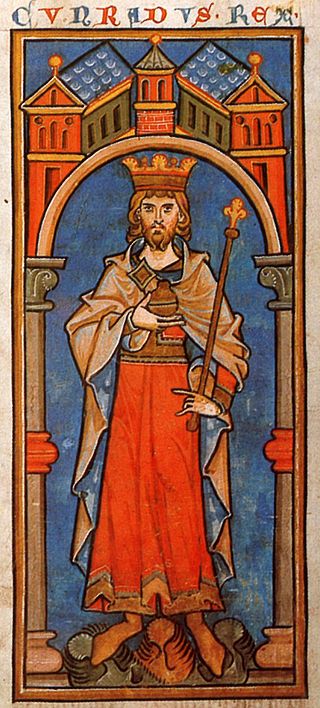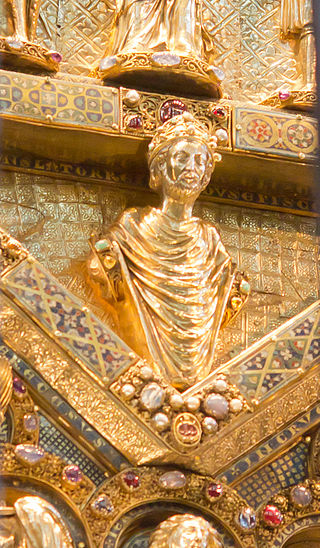Life
Eberhard was born to a noble family of Nuremberg, Germany; he became a Benedictine in 1125 at Pruffening, Germany. Later he was made Abbot of Biburg near Regensburg. In 1146 Pope Innocent II appointed him Archbishop of Salzburg. [1]
He rose to fame as a mediator when Pope Alexander III was faced with the controversy surrounding the Papal election of 1159, created by Holy Roman Emperor Frederick I Barbarossa who supported antipope Victor IV. Eberhard wrote to Hildegard of Bingen, requesting her prayers during this stressful time. [2] Eberhard intended to attend the Council of Pavia in 1160, but only got as far as Treviso due to ill health. [3]
Although Archbishop Eberhard I, Count of Hippoldstein, steadily supported Alexander, Barbarossa left him in peaceful possession of his see. [4] Frederick saw Eberhard as a potential arbiter. Eberhard was greatly respected for his piety, learning, and integrity; and Frederick needed the support of the German princes for his Italian campaigns.
Eberhard was one of the most able of the prelates of his age. [1] He died in 1164, at the age of seventy-nine, returning from another peace keeping mission. [5]

Hildegard of Bingen, also known as Saint Hildegard and the Sibyl of the Rhine, was a German Benedictine abbess and polymath active as a writer, composer, philosopher, mystic, visionary, and as a medical writer and practitioner during the High Middle Ages. She is one of the best-known composers of sacred monophony, as well as the most recorded in modern history. She has been considered by a number of scholars to be the founder of scientific natural history in Germany.

Pope Alexander III, born Roland, was head of the Catholic Church and ruler of the Papal States from 7 September 1159 until his death in 1181.

Frederick Barbarossa, also known as Frederick I, was the Holy Roman Emperor from 1155 until his death 35 years later in 1190. He was elected King of Germany in Frankfurt on 4 March 1152 and crowned in Aachen on 9 March 1152. He was crowned King of Italy on 24 April 1155 in Pavia and emperor by Pope Adrian IV on 18 June 1155 in Rome. Two years later, the term sacrum ("holy") first appeared in a document in connection with his empire. He was later formally crowned King of Burgundy, at Arles on 30 June 1178. He was named Barbarossa by the northern Italian cities which he attempted to rule: Barbarossa means "red beard" in Italian; in German, he was known as Kaiser Rotbart, which in English means "Emperor Redbeard." The prevalence of the Italian nickname, even in later German usage, reflects the centrality of the Italian campaigns to his career.

Conrad III of the Hohenstaufen dynasty was from 1116 to 1120 Duke of Franconia, from 1127 to 1135 anti-king of his predecessor Lothair III, and from 1138 until his death in 1152 King of the Romans in the Holy Roman Empire. He was the son of Duke Frederick I of Swabia and Agnes, a daughter of the Salian Emperor Henry IV.

The Prince-Archbishopric of Salzburg was an ecclesiastical principality and state of the Holy Roman Empire. It comprised the secular territory ruled by the archbishops of Salzburg, as distinguished from the much larger Catholic diocese founded in 739 by Saint Boniface in the German stem duchy of Bavaria. The capital of the archbishopric was Salzburg, the former Roman city of Iuvavum.
Victor IV was elected as a Ghibelline antipope in 1159, following the death of Pope Adrian IV and the election of Alexander III. His election was supported by Emperor Frederick Barbarossa. He took the name Victor IV, not acknowledging Antipope Victor IV of 1138, whose holding of the papal office was deemed illegitimate.

Antipope Paschal III was a 12th-century clergyman who, from 1164 to 1168, was the second antipope to challenge the reign of Pope Alexander III. He had previously served as Cardinal of St. Maria.

Rainald of Dassel was Archbishop of Cologne and Archchancellor of Italy from 1159 until his death. A close advisor to the Hohenstaufen emperor Frederick Barbarossa, he had an important influence on Imperial politics, mainly in the Italian conflict of Guelphs and Ghibellines.
Wibald was a 12th-century Abbot of Stavelot (Stablo) and Malmedy, both in present-day Belgium, and of Corvey in Germany. He figured prominently in the court circle of the German kings of his time.
Conrad of Wittelsbach was the Archbishop of Mainz and Archchancellor of Germany from 20 June 1161 to 1165 and again from 1183 to his death. He was also a cardinal of the Roman Catholic Church.

Hillin of Falmagne (German: Hillin von Fallemanien, also spelled Falemagne, Fallemanien, Fallenmaigne, etc.) (c. 1100 – 23 October 1169), was the Archbishop of Trier from 1152. He was an imperialist and a partisan of Frederick Barbarossa in the Investiture Controversy of the twelfth century.

The Archdiocese of Tarentaise was a Roman Catholic diocese and archdiocese in France, with its see in Moûtiers, in the Tarentaise Valley in Savoie. It was established as a diocese in the 5th century, elevated to archdiocese in 794, and disbanded in 1801. The diocese of Tarentaise was again formed in 1825, and united with the diocese of Chambéry and diocese of Saint-Jean-de-Maurienne to form the Archdiocese of Chambéry, Maurienne and Tarentaise in 1966.
Wichmann von Seeburg was Bishop of Naumburg from 1150 until 1154 and Archbishop of Magdeburg from 1154 until his death. He became the first Magdeburg prince-archbishop in 1180
Henry, in German Heinrich, was the archbishop of Mainz from September 1142 until his deposition in June 1153.

The Archdiocese of Salzburg is a Latin Church archdiocese of the Catholic Church in Austria. The archdiocese is one of two Austrian archdioceses, serving alongside the Archdiocese of Vienna.

The Diocese of Gurk-Klagenfurt is a Latin Church diocese of the Catholic Church covering the Austrian state of Carinthia. It is part of the ecclesiastical province of Salzburg. Though named after Gurk Cathedral, the bishop's see since 1787 has been in Klagenfurt.
Blessed Hartmann of Brixen was a German prelate of the Catholic Church, who served as the Bishop of Brixen from his appointment in 1140 until his death. Hartmann served alongside the Order of Saint Augustine - who oversaw his education - and he managed certain aspects of their order despite not being part of that congregation. He also supported Pope Alexander III during his struggle with Frederick Barbarossa and also earned the favor of the latter despite Hartmann's views of the schism.

Conrad of Babenberg was a nobleman and prelate of the Holy Roman Empire. He was the bishop of Passau from 1148/1149 until 1164 and then archbishop of Salzburg and Primate until his death, although he lost control of Salzburg when he was placed under the imperial ban in 1166.
The Concordat of 1161 was an agreement between the Kingdom of Hungary and the Papal States, signed by Géza II of Hungary and papal legate Pietro di Miso in late summer or early autumn 1161. The Hungarian monarch squeezed out significant church government concessions for himself in exchange for switching sides and pledging support for Pope Alexander III against the Ghibelline Antipope Victor IV.












